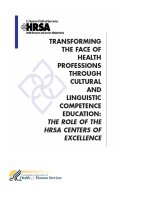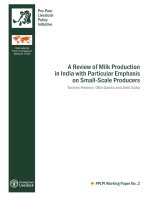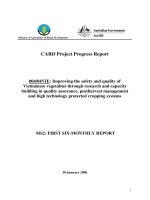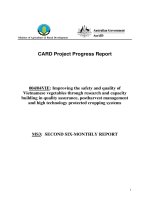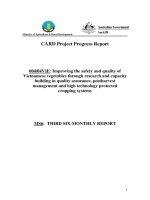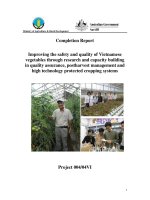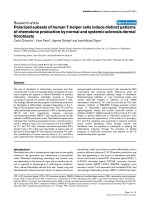Increase of microalgal production through symbiosis and scale up mircroalgal cultivation
Bạn đang xem bản rút gọn của tài liệu. Xem và tải ngay bản đầy đủ của tài liệu tại đây (5.36 MB, 225 trang )
INCREASE OF MICROALGAL PRODUCTION THROUGH SYMBIOSIS AND SCALE-UP
MICROALGAL CULTIVATION
GUO ZHI
(B.Eng., Beijing University of Chemical Technology)
A THESIS SUBMITTED
FOR THE DEGREE OF DOCTOR OF
PHILOSOPHY
DEPARTMENT OF CHEMICAL &
BIOMOLECULAR ENGINEERING
NATIONAL UNIVERSITY OF SINGAPORE
2014
DECLARATION
“I hereby declare that this thesis is my original work and it has been written
by me in its entirety. I have duly acknowledged all the sources of information
which have been used in this thesis. This thesis has also not been submitted
for any degree in any university previously.”
Guo Zhi
10 Jan 2014
a
Acknowledgements
ACKNOWLEDGEMENTS
The completion of my research depends on the encouragement and guidance
of many people. I take this opportunity to express my sincere gratitude to
these people who have been contributory in the successful completion of this
thesis.
First and foremost, I would like to express my deepest and most sincere
gratitude to my supervisor, Professor Tong Yen Wah, for giving me the
precious opportunities to carry out my research work. His passion in scientific
research and tireless mentorship are the key motivating factors behind my
successful completion for this thesis. I am sincerely grateful to his invaluable
patience and advice in research. He also gives me a lot of helpful suggestions
in my life. Here, I do very appreciate your help and guidance during these
challenging but wonderful years. Thank you very much!
I would like to show my appreciation to Professor Chung, Tai-Shung Neal and
Professor He Jianzhong for their generous time and guidance during my
research.
I want to show my thanks to all the past and present members of the Prof.
Tong’s group, in particular: Koh Shirlaine, Chen Wen Hui, Niranjani
i
Acknowledgements
Sankarakumar, Liang Youyun, Chen Yiren, Anjaneyulu Kodali, Wang Honglei,
Xie Wenyuan, Ajitha Sundaresan, He Fang, Wang Bingfang, Sushmitha
Sundar, Wang Liang, Ingo Tim Wolf, Zhou Danhua, Lee Jonathan and Liang
Yiyun, for their unconditional help, suggestion and support. I would like to
thank other groups’ members, especially Deny Hartono, Harleen Kaur, Fong
Kah Ee, Dai Meng Qiao, Prashant Praveen, Vu-Tran Khanh Linh, Chen Xiyu
and Wang Peng, for their valuable advice in my research. I am also grateful to
my dear friends, Wang Rong, Yu Rui, Zhou Rui, Xu Liqun, Zhang Bin and
Han Gang, for their support and encouragement during my hard time. In
addition, I would like to thank our lab officers, Ms. Li Fengmei, Dr. Yang
Liming, Ms. Li Xiang, Mr. Evan Stephen Tan, Mr. Ang Wee Siong, Mr. Lim
Hao Hiang, Joey, Mr. Qin Zhen, Md. Teo Ai Peng, Mr. Ng Kim Poi and Mr.
Chuin Mun Alistair. Without their help, I could not finish my research work in
time. I also want to show my appreciation to the Department of Chemical and
Biomolecular Engineering, National University of Singapore for providing the
research scholarship and living stipend as well as research opportunity and
facilities that make this study possible.
Last but not least, I would like to thank my parents for their unconditional
support, patience, understand and love, which make me successfully
overcome all the difficulties and challenges in my life. Finally, I would like to
thank my dearest girl, Wu Yin, for her selfless support and love.
ii
Table of contents
TABLE OF CONTENTS
SUMMARY .......................................................................................................... vii
LIST OF TABLES .................................................................................................. x
LIST OF FIGURES .............................................................................................. xii
LIST OF ABBREVIATIONS ............................................................................. xvii
LIST OF SYMBOLS ............................................................................................ xx
CHAPTER 1 ........................................................................................................... 1
1.1 Background ................................................................................................ 2
1.2 Hypothesis.................................................................................................. 4
1.3 Research objective ..................................................................................... 5
CHAPTER 2 ........................................................................................................... 8
2.1 Global energy problem .............................................................................. 9
2.2 GHG emissions ........................................................................................ 11
2.3 Biofuels .................................................................................................... 11
2.4 Biomass .................................................................................................... 13
2.5 Biorefinery ............................................................................................... 14
2.6 Algae ........................................................................................................ 15
2.6.1 Cyanobacteria ................................................................................ 16
2.6.2 Chlorophyta.................................................................................... 17
2.7 Photosynthesis in microalgae................................................................... 18
2.7.1 Photosynthetic membranes and chloroplast ................................... 20
2.7.2 Photosynthetic pigments ................................................................ 20
2.7.3 Photorespiration ............................................................................. 21
2.8 Microalgal cultivation .............................................................................. 22
2.8.1 Cultivation parameters ................................................................... 23
2.8.2 Cultivation nutrients....................................................................... 28
2.8.3 Cultivation systems ........................................................................ 31
2.9 Harvest ..................................................................................................... 34
2.10 Application of microalgae ...................................................................... 36
2.10.1 Feedstock for biofuels .................................................................. 36
2.10.2 Food commodities and pharmaceuticals from microalgae .......... 39
2.10.3 Wastes treatment .......................................................................... 40
CHAPTER 3 ......................................................................................................... 43
3.1 Microalgae ............................................................................................... 44
3.2 Culture medium for C. vulgaris ............................................................... 44
3.3 C. vulgaris culture in the lab .................................................................... 44
3.4 Outdoor cultivation of C. vulgaris ........................................................... 46
iii
Table of contents
3.5 Analytical methods................................................................................... 46
3.5.1 pH and dissolved oxygen measurement ......................................... 46
3.5.2 Outdoor cultivation parameters measurement ............................... 46
3.5.3 Nitrate and phosphate concentration measurement ....................... 47
3.5.4 Extracellular organic carbon measurement .................................... 47
3.5.5 Biomass concentration measurement ............................................. 47
3.5.6 Lipid extraction and measurement ................................................. 48
3.5.7 Carbohydrate extraction and measurement .................................... 49
3.5.8 Protein extraction and measurement .............................................. 50
3.5.9 Chlorophyll extraction and measurement ...................................... 51
3.5.10 Photosynthetic efficiency measurement ...................................... 51
3.5.11 CO2 fixation rate and CO2 to biomass conversion efficiency ...... 52
3.5.12 Fatty acids analysis ...................................................................... 53
3.5.13 Elemental analysis ....................................................................... 54
3.5.14 Scanning Electron Microscopy .................................................... 54
3.6 Statistical analysis .................................................................................... 55
3.7 Specific experimental section of chapter 4 .............................................. 55
3.7.1 Isolation of symbiotic bacteria from C. vulgaris culture ............... 55
3.7.2 Identification of symbiotic bacteria ............................................... 56
3.7.3 Purification of C. vulgaris culture ................................................. 56
3.7.4 Co-culture C. vulgaris and symbiotic bacteria .............................. 57
3.8 Specific experimental section of chapter 5 .............................................. 58
3.8.1 Adjustment of different CO2 input conditions for outdoor
culture of C. vulgaris in bubble columns ................................................ 58
3.9 Specific experimental section of chapter 6 .............................................. 59
3.9.1 First-stage cultivation in outdoor environment .............................. 59
3.9.2 Harvest between the first and second stage ................................... 59
3.9.3 Second-stage cultivation in outdoor environment ......................... 60
3.9.4 Equations for the determination of biodiesel properties ................ 61
CHAPTER 4 ......................................................................................................... 63
4.1 Introduction .............................................................................................. 64
4.2 Results ...................................................................................................... 66
4.2.1 Observation of C. vulgaris and symbionts ..................................... 66
4.2.2 Isolation and characterization of symbiotic bacteria ..................... 67
4.2.3 Effect of symbiotic bacteria on the growth of C. vulgaris ............. 70
4.2.4 Analysis of EOC in culture ............................................................ 74
4.2.5 Analysis of chlorophyll amount ..................................................... 75
4.2.6 Analysis of photosynthetic efficiency ............................................ 76
4.3 Discussion ................................................................................................ 77
4.4 Summary .................................................................................................. 86
CHAPTER 5 ......................................................................................................... 88
5.1 Introduction .............................................................................................. 89
5.2 Results ...................................................................................................... 93
iv
Table of contents
5.2.1 Effects of gas flow rate and different CO2 input conditions on
the growth of C. vulgaris ........................................................................ 93
5.2.2 Effects of different CO2 input conditions on the elemental
proportion of C. vulgaris......................................................................... 96
5.2.3 Effects of different CO2 input conditions on the CO2 fixation of
C. vulgaris ............................................................................................... 97
5.2.4 Effects of different CO2 concentration in aeration on the
dissolved CO2 concentration in medium/algal culture............................ 99
5.2.5 Effects of different CO2 input conditions on the yields of FAME,
protein and carbohydrate in C. vulgaris................................................ 100
5.2.6 Effects of different CO2 input conditions on the composition of
FAMEs in C. vulgaris ........................................................................... 102
5.3 Discussion .............................................................................................. 104
5.4 Summary .................................................................................................111
CHAPTER 6 ....................................................................................................... 113
6.1 Introduction ............................................................................................ 114
6.2 Results .................................................................................................... 117
6.2.1 C. vulgaris growth and nutrients profiles in the first-stage
cultivation ............................................................................................. 117
6.2.2 C. vulgaris lipid profiles and compositions in the first-stage
cultivation ............................................................................................. 119
6.2.3 C. vulgaris growth profiles under different stress conditions in
the second-stage cultivation .................................................................. 121
6.2.4 C. vulgaris lipid profiles and compositions under different
stress conditions in the second-stage cultivation .................................. 124
6.2.5 The quality determination of C. vulgaris FAMEs........................ 129
6.3 Discussion .............................................................................................. 130
6.4 Summary ................................................................................................ 136
CHAPTER 7 ....................................................................................................... 143
7.1 Synergistic microalgae-bacterial relationship as an approach to
increase microalgal production .................................................................... 145
7.2 Scaling up microalgal culture to increase algal production and
optimizing CO2 usage during algal cultivation ............................................ 147
7.3 Two-stage cultivation strategy to increase algal biomass production
and lipid productivity ................................................................................... 149
7.4 Suggestions for future work ................................................................... 151
7.5 Preliminary studies for future work: Designing novel PBR for
microalgal production .................................................................................. 153
BIBLIOGRAPHY ............................................................................................... 157
APPENDIX A ..................................................................................................... 198
APPENDIX B ..................................................................................................... 200
APPENDIX C ..................................................................................................... 201
v
Table of contents
vi
Summary
SUMMARY
The global energy crisis has motivated reevaluations of energy-intensive
activities and processes in the urban living environment, to identify areas where
fossil fuel energy dependence can be reduced through the use of alternative
energy. Biofuels have triggered an intensification of research into alternative
energies, due to their renewable and carbon neutral characters. Microalgae are
considered the most promising feedstock for the next generation of biofuels
because they have several major advantages, compared to the feedstock of first(food feedstock) and second- (non-food feedstock) generation biofuels.
However, one major challenge of microalgal biofuels lies in algal biomass
production. Therefore, this thesis was designed to increase microalgal
production through different approaches.
The first objective of this project was to investigate potential approach for
promoting microalgal growth in the lab. Synergistic microalgae-bacterial
interaction was proposed to increase microalgal concentration. Three
symbiotic bacteria were isolated from the long-term operated C. vulgaris
culture and identified by 16S rDNA analysis. One symbiotic bacteria
Pseudomonas sp. was found to have a growth promoting effect (1.4 times
higher algal cell concentration than single algal culture) on C. vulgaris when
they were co-cultured under photoautotrophic conditions. The chlorophyll
vii
Summary
content in C. vulgaris cell was higher in co-culture than in single algal culture.
The mutualistic relationship between microalgae and their symbiotic bacteria
could be used as one method to increase microalgal production.
The second objective was to investigate the feasibility of scaling up
microalgal culture to increase the production yield. C. vulgaris was
successfully cultivated in pilot-scale bubble columns (80 L) under tropical
outdoor conditions. The constant supply of CO2 in microalgal culture was
found to be non-essential. It was found that when 2% CO2 was intermittently
supplied (1 h 2% CO2 enriched air/1 h air) or 2% & 4% CO2 was alternatively
aerated (30 min 4% CO2 enriched air twice and 1 h 2% CO2 enriched air
twice), the algal growth was not affected as compared to having a constant
supply of 2% CO2 while the amount of CO2 used was reduced by 50% and CO2
to biomass conversion efficiency was doubled. Outdoor culture and adjusting
proper CO2 input conditions can be suggested in microalgal production so as to
save energy and cultivation cost.
The third objective of this project was to investigate method of increasing the
algal biomass and their lipid productivities in outdoor environments. A
two-stage cultivation strategy was applied, to obtain sufficient algal biomass
in the first stage and to accumulate lipids under stress conditions in the second
stage. After 8-d cultivation in the first stage, a 1.5 g L-1 biomass yield average
viii
Summary
can be achieved. Nitrogen and phosphorus limitation as well as salinity stress
were induced in the second-stage cultivation. It was found that C. vulgaris
accumulated lipid under nitrogen and phosphorus limiting conditions. Salinity
stress cannot induce higher lipid content compared with the control, but did
promoted algal growth. The highest average lipid productivity was 92.60 mg
L-1 d-1. Algal biomass harvest could be suggested at the time when the lipid
yields were at their maximum. The relatively constant fatty acid percentage
observed in this study showed that the properties of FAMEs obtained would
be stable, and these FAMEs could be used as biodiesel since they meet the
requirements of EN 14214 and ASTM D 6751.
ix
List of tables
LIST OF TABLES
Table 5.1
The maximum biomass concentration and biomass productivity of C. vulgaris
ATCC 13482 under different CO2 concentrations (means ± SD)
Table 5.2
The maximum biomass concentration and biomass productivity of C. vulgaris
ATCC 13482 under different CO2 input conditions (*normalized data) (means
± SD)
Table 5.3
The carbon (C), hydrogen (H), nitrogen (N) and oxygen (O) content of C.
vulgaris ATCC 13482 under different CO2 concentrations (means ± SD)
Table 5.4
The carbon (C), hydrogen (H), nitrogen (N) and oxygen (O) content of C.
vulgaris ATCC 13482 under different CO2 input conditions (*normalized data)
(means ± SD). a: Oxygen content: O% = 100% - C% - H% - N%
Table 5.5
The CO2 fixation rate and CO2 to biomass conversion efficiency of C. vulgaris
ATCC 13482 under different CO2 concentrations (means ± SD)
Table 5.6
The CO2 fixation rate and CO2 to biomass conversion efficiency of C. vulgaris
ATCC 13482 under different CO2 input conditions (*normalized data) (means
± SD)
Table 5.7
Main FAs content in C. vulgaris ATCC 13482 under different CO2
concentrations (means ± SD)
Table 5.8
Main FAs content in C. vulgaris ATCC 13482 under different CO2 input
conditions (*normalized data) (means ± SD). n.d: not detected
x
List of tables
Table 5.9
Typical average CO2 reduction rate under different CO2 concentrations
Table 5.10
Comparison of total CO2 consumption in Chlorella cultivations reported in the
literature and this study
Table 6.1
The average lipid productivity and max lipid yield under different stress
conditions during the second-stage cultivation
Table 6.2
The properties of FAMEs obtained in this study
xi
List of figures
LIST OF FIGURES
Fig. 2.1
World energy consumption from 1986 to 2011 in million tons of oil
equivalents (adapted from British Petroleum 2012)
Fig. 2.2
Average annual oil prices from 1980 to 2035 (US$ per barrel) (adapted from
DOE/EIA 2012)
Fig. 2.3
Different algal culture systems designed in this project. The simulated 50 L
open pond (a); vertical bubble columns (b); 50 L air-lift flat plate PBR (c)
Fig. 2.4
Flow chart of microalgal biofuel production combined with wastewater
treatment and CO2 mitigation (adapted from (Costa and de Morais 2011), got
official license of reusing it in this thesis from the publisher. License Number:
3306851312834))
Fig. 4.1
Observation of the C. vulgaris with associated symbionts under scanning
electron microscope. Arrows indicate symbionts attached on the surface of C.
vulgaris. The scaling bar at the center of bottom represents 5µm in size
Fig. 4.2
Neighbor-jointing phylogenetic trees based on 16S rDNA analysis. The
numbers at nodes represent bootstrap values resampled 1000 times
Fig. 4.3
Algal cell concentration in co-culture with three associated bacterial strains
under photoautotrophic condition (a). Single algal culture (- ◆ -), with
Pseudomonas sp. (-■-), with Methylobacterium sp. (-▲-) and, with
Elizabethkingia sp. (-●-); Algal cell concentration in co-culture with
Pseudomonas sp. under photoheterotrophic condition (b). Single algal culture
(-◆-), with Pseudomonas sp. (-■-)
xii
List of figures
Fig. 4.4
Pseudomonas sp. concentration(-●-) under photoautotrophic condition (a);
Pseudomonas sp. concentration under photoheterotrophic condition (b). Only
Pseudomonas sp.(-▲-), Pseudomonas sp. with algae(-●-)
Fig. 4.5
EOC profile of single algal culture (■) and co-culture of algae with
Pseudomonas sp. (□) under photoautotrophic conditions. * showed data were
statistically significant different (p<0.05)
Fig. 4.6
Chlorophyll content of single algal culture (■) and co-culture of algae with
Pseudomonas sp. (□) under photoautotrophic (a,b) and photoheterotrophic
(c,d) conditions. a,c shows the cholorophyll content of a and b per liter of cell
broth; b,d shows the chlorophyll content in single C. vulgaris cell. * showed
data were statistically significant different (p<0.05)
Fig. 4.7
Photosynthetic efficiency (Fv/Fm) of single algal culture (-■-,-▲-) and
co-culture of algae with Pseudomonas sp. (-●-,-▼-) under photoautotrophic
and photoheterotrophic conditions
Fig. 4.8
The DO profile of single algal culture (-▲-) and co-culture of algae with
Pseudomonas.sp. (-■-) under photoautotrophic condition (a) and
photoheterotrophic condition (b)
Fig. 4.9
The pH profile of single algal culture (-▲-) and co-culture of algae with
Pseudomonas sp. (-■-) under photoautotrophic condition (a) and
photoheterotrophic condition (b)
Fig. 5.1
The setup of outdoor microalgae cultivation bubble columns system
xiii
List of figures
Fig. 5.2
Different CO2 input conditions: condition A: 2% CO2 provided intermittently
(1 h 2% CO2 enriched air/1 h air) (a); condition B: 4% CO2 provided
intermittently (40 min 4% CO2 enriched air thrice per day) (b); condition C: 2%
& 4% CO2 alternatively supplied (30 min 4% CO2 enriched air twice and 2%
CO2 enriched air 1 h twice) (c); condition D: 2% CO2 provided corresponding
to the increase of algal biomass concentration (d)
Fig. 5.3
Biomass concentration (g L-1) for C. vulgaris ATCC 13482 cultivated in
bubble columns under outdoor conditions. Effects of gas flow rates (a), effects
of different CO2 concentrations (b), and effects of CO2 input conditions (c*
normalized data)
Fig. 5.4
Dissolved CO2 concentration under different CO2 concentrations in sparging
in C. vulgaris broth and culture medium
Fig. 5.5
FAMEs, carbohydrates and proteins yields of C. vulgaris under different CO2
input conditions (means ± SD): Effects of different CO2 concentrations (a),
effects of CO2 input conditions (b*normalized data)). * showed data were
statistically significant difference (p<0.05)
Fig. 5.6
The change of sunlight intensity, dissolved oxygen concentration and pH in C.
vulgaris culture on a typical day in tropical outdoor environment
Fig. 6.1
The sedimentation of microalgae at the bottom of bubble columns during the
harvest in between first- and second-stage cultivation
Fig. 6.2
The growth curve of C. vulgaris and nitrogen & phosphorus change profiles
during the first-stage cultivation (means ± SD)
xiv
List of figures
Fig. 6.3
Lipid content and lipid yield during the first-stage cultivation (means ± SD)
Fig. 6.4
The profiles of fatty acid percentage during the first-stage cultivation
Fig. 6.5
The growth curves of C. vulgaris under different stress conditions during the
second-stage cultivation (means ± SD)
Fig. 6.6
Lipid content under different stress conditions during the second-stage
cultivation (means ± SD)
Fig. 6.7
Lipid yield under different stress conditions during the second-stage
cultivation (means ± SD)
Fig. 6.8
The profiles of fatty acid percentage under nitrogen limiting conditions
(second-stage cultivation)
Fig. 6.9
The profiles of fatty acid percentage under phosphorus limiting conditions
(second-stage cultivation)
Fig. 6.10
The profiles of fatty acid percentage under salinity stress conditions
(second-stage cultivation)
Fig. 6.11
The profiles of fatty acid percentage under nitrogen limiting with CO2
sparging conditions (second-stage cultivation)
xv
List of figures
Fig. 6.12
The profiles of fatty acid percentage under phosphorus limiting with CO2
sparging conditions (second-stage cultivation)
Fig. 6.13
The profiles of fatty acid percentage under salinity stress with CO2 sparging
conditions (second-stage cultivation)
Fig. 7.1
The structure diagram of sieve tray column
Fig. 7.2
The scheme of whole system used for microalgae cultivation
Fig. 7.3
The photo of running sieve tray column microalgae cultivation system
xvi
List of abbreviations
LIST OF ABBREVIATIONS
ANOVA: Analysis of Variance
ATP: Adenosine Triphosphate
BLAST: Basic Local Alignment Search Tool
BSA: Bovine Serum Albumin
CFU: Colony-Forming Units
DCW: Dry Cell Weight
DI water: Deionized water
DNA: Deoxyribonucleic Acid
DO: Dissolved Oxygen
EOC: Extracellular Organic Carbon
ETC: Electron Transport Chain
FAME: Fatty Acid Methyl Ester
xvii
List of abbreviations
FA: Fatty Acid
GC-MS: Gas Chromatography–Mass Spectrometry
GHG: Greenhouse Gas
ID: Inner Diameter
LEDs: Light-Emitting Diodes
MUFA: Mono-Unsaturated Fatty Acid
NADPH: Nicotinamide Adenine Dinucleotide Phosphate
IAA: Indole-3-Acetic Acid
PBR: Photobioreactor
PGPB: Plant Growth Promoting Bacteria
PUFA: Poly-Unsaturated Fatty Acid
RuBisCO: Ribulose-1,5-Bisphosphate Carboxylase Oxygenase
xviii
List of abbreviations
SD: Standard Deviation
SEM: Scanning Electron Microscope
SFA: Saturated Fatty Acid
TAG: Triglyceride
TOC: Total Organic Carbon
UV: Ultra Violet
xix
List of symbols
LIST OF SYMBOLS
A650: Absorbance at the light wavelength of 650 nm
A665: Absorbance at the light wavelength of 665 nm
Ct: Biomass concentration at time point t (g L-1)
C0: Initial biomass concentration (g L-1)
Ccarbon: Carbon content in algal biomass (%)
Contentlipid: Total lipid content (%)
CN: cetane number
db: number of double bonds in the fatty acid
ECO2: CO2 to biomass conversion efficiency (%)
Fv: Fluorescence variance
F0: Initial fluorescence
Fm: Maximum fluorescence
m: number of carbon atoms in the alcohol used for the transesterification
reaction
Mc: Molecular weight of C (carbon)
xx
List of symbols
MCO2: Molecular weight of CO2
n: number of carbon atoms in the original fatty acid
ppm: Parts Per Million
PBiomass: Biomass productivity (g L-1 d-1)
Plipid: Lipid productivity (mg L-1 d-1)
PCO2: CO2 fixation rate (g CO2 L-1 d-1)
t: Cultivation period (d)
vvm: Volume gas per Volume medium per Minute
Vcolumn: Working volume of bubble column (L)
VCO2: Volume of total consumed CO2 during cultivation (L)
Wtotal: Weight of glass vial with algal lipids (mg)
Wvial: Weight of glass vial (mg)
Wbiomass: Weight of algal biomass (mg)
z: content of the linoleic and linolenic acids (wt.%)
xxi
List of symbols
ρCO2: Density of CO2 (g L-1)
ρBiodiesel: Density of biodiesel (kg m-3)
ν: Kinematic viscosity (mm2 s-1)
xxii
Chapter 1
CHAPTER 1
INTRODUCTION
A brief background of the microalgae based biofuels, motivation, hypothesis
as well as research objectives of this Ph.D. thesis will be presented in this
chapter.
1
